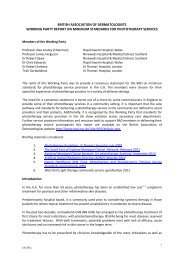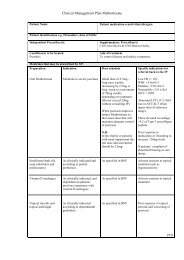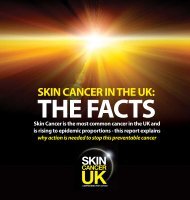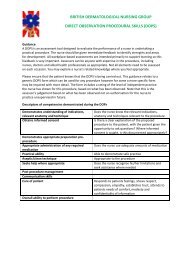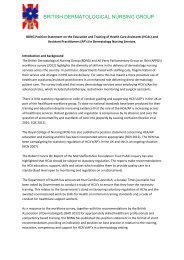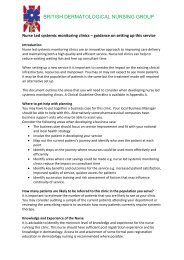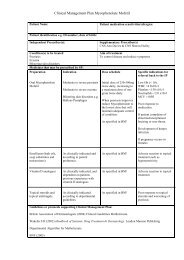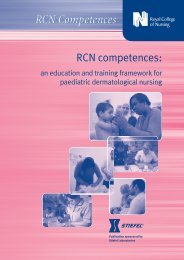Improving outcomes for people with skin tumours including melanoma
Improving outcomes for people with skin tumours including melanoma
Improving outcomes for people with skin tumours including melanoma
Create successful ePaper yourself
Turn your PDF publications into a flip-book with our unique Google optimized e-Paper software.
Histopathology services <strong>for</strong> <strong>skin</strong> cancer should be part of a managed<br />
pathology network or equivalent model.<br />
Histopathology reporting should be provided by histopathologists<br />
who participate in EQA. This may be a general histopathology EQA<br />
scheme that includes <strong>skin</strong> or a more specialist <strong>skin</strong> EQA scheme.<br />
When appropriate, the EQA scheme should cover lymphoma. Given<br />
the overlap <strong>with</strong> head and neck cancer services, it should be noted<br />
that the head and neck histopathology EQA scheme includes <strong>skin</strong><br />
cases.<br />
<strong>Improving</strong> Outcomes <strong>for</strong><br />
People <strong>with</strong> Skin Tumours<br />
<strong>including</strong> Melanoma<br />
Initial investigation,<br />
diagnosis, staging and<br />
management<br />
All histopathology reports relating to <strong>skin</strong> cancer should con<strong>for</strong>m to<br />
the Royal College of Pathologists minimum datasets 46 on cancer in<br />
order to provide adequate and appropriate in<strong>for</strong>mation on prognosis,<br />
planning individual patient treatment, supporting epidemiology and<br />
research, and to evaluate clinical services and support clinical<br />
governance.<br />
SNB samples <strong>for</strong> <strong>skin</strong> cancer should be examined and reported by<br />
specialists <strong>with</strong> a registered qualification in histopathology. It is<br />
desirable that SNB samples resulting from <strong>skin</strong> cancer are handled<br />
and reported by the same team of pathologists involved in the<br />
reporting of <strong>skin</strong> cancer. The technical processing of SNB samples<br />
must con<strong>for</strong>m to recognised national or international protocols (such<br />
as that used by the European Organisation <strong>for</strong> Research and<br />
Treatment of Cancer (EORTC) 47 ).<br />
4<br />
All MMs and severely atypical naevi should be double-reported if<br />
resources allow the report to be generated <strong>with</strong>in 2 weeks. The<br />
acknowledged current shortfall of an NHS histopathology work<strong>for</strong>ce<br />
in some centres could delay this quality recommendation. Although it<br />
is ideal that all melanocytic lesions are double-reported to avoid<br />
missing MM, it is likely to be many years be<strong>for</strong>e the NHS<br />
histopathology work<strong>for</strong>ce could achieve this.<br />
Given an adequate histopathology work<strong>for</strong>ce in the medium to long<br />
term, it is desirable that eventually all <strong>skin</strong> cancers are doublereported<br />
to achieve consistency and accuracy in diagnosis. It is also<br />
recognised that alternative models to double-reporting of MM exist,<br />
such as consensus meetings out<strong>with</strong> the MDT. These are equally<br />
acceptable so long as all potential MDT cases are discussed and the<br />
meetings <strong>for</strong>mally minuted <strong>with</strong> regard to attendance and diagnosis. 48<br />
46 Royal College of Pathologists. Standards and datasets <strong>for</strong> reporting cancers. Available<br />
from: www.rcpath.org<br />
47 www.eortc.be<br />
48 Department of Health (2004) Manual <strong>for</strong> cancer services. Available from: www.dh.gov.uk<br />
Guidance on cancer services: <strong>skin</strong> <strong>tumours</strong> <strong>including</strong> <strong>melanoma</strong> 85




